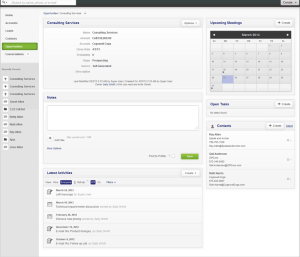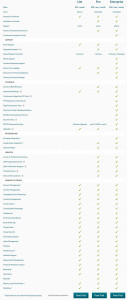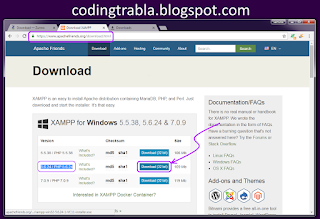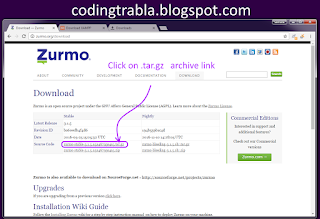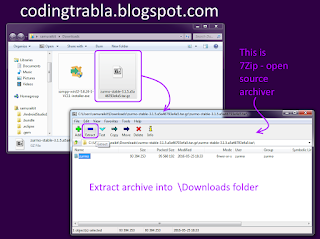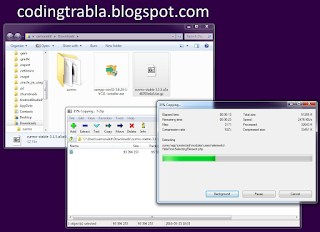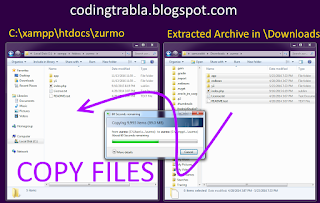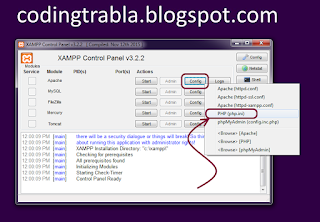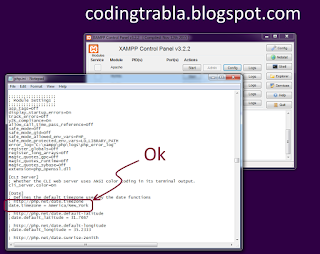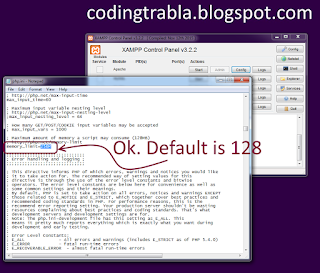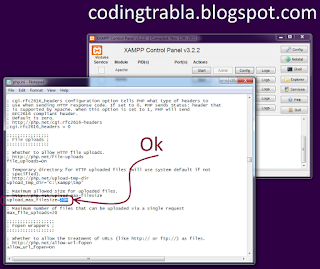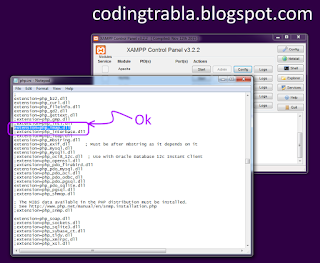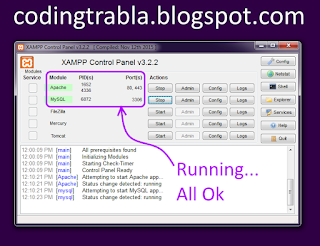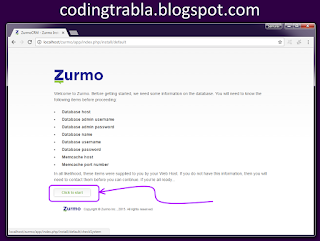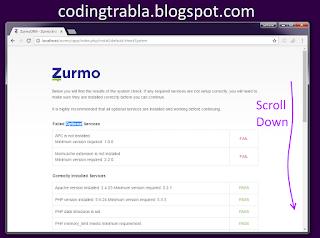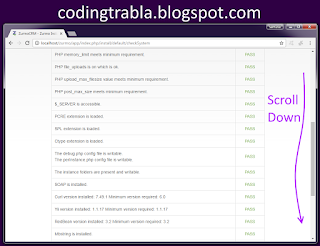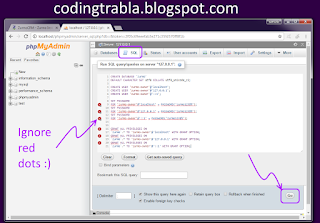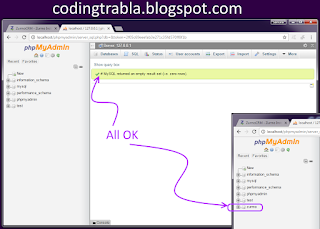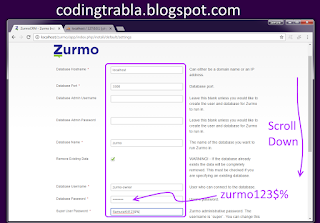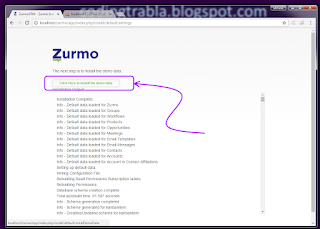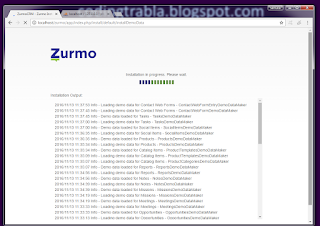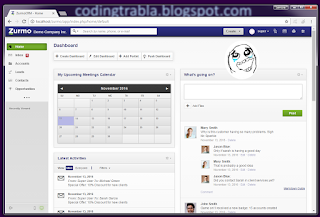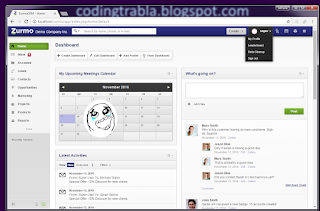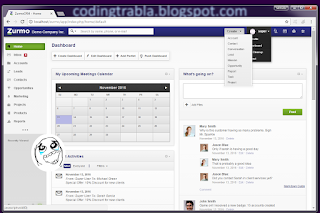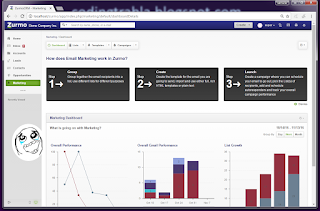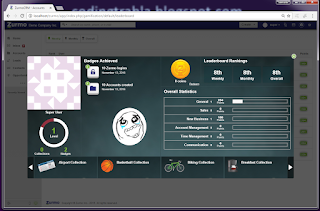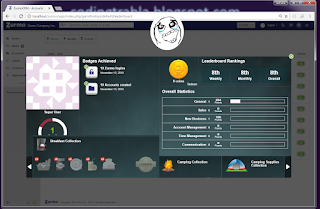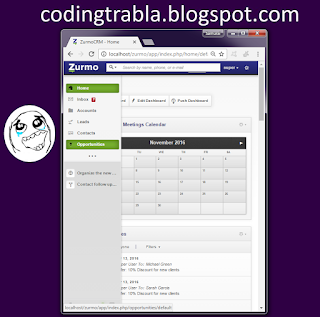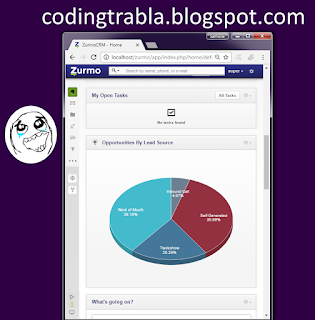1-click AWS Deployment 1-click Azure Deployment 1-click Google Deployment
Overview
Zurmo is an Open Source Customer Relationship Management (CRM) application that is mobile, social and gamified. We use a test-driven methodology for building every part of the application.
Zurmo is an open source CRM application that is mobile, social, and gamified. Although located in Chicago, USA, Zurmo has an international footprint with contributors and end users all over the world. Language support includes English, Spanish, French, German, and Italian.
In 2010, the founders of Zurmo saw an opportunity to build a better open source CRM application based on better technology and progressive user adoption methodologies. Zurmo is written in PHP utilizing jQuery, Yii Framework, and RedBeanPHP. With these robust development frameworks in place and using a Test Driven Development (TDD) methodology, Zurmo is an application that is one of a kind. With an almost religious zeal for testing, you will find that our obsession with TDD means a more stable application. Gone are the days of ‘upgrade and pray’. Now it is ‘upgrade and test’. With the testing infrastructure in place, you can create and maintain a custom-built CRM system with the assurance that future updates are not going to break your installation.
Yes, we know there are a lot of CRM applications out there. Why another one? Through our many years in the CRM industry, we still see companies struggling to implement a CRM application. The objective of Zurmo is to provide an easy-to-use, easy-to-customize CRM application that can be adapted to any business use case. We have taken special care to think through many different use cases and have designed a system that provides a high degree of flexibility, covering a wide variety of use cases out of the box.
Gamification and socialCRM functionality have increased user adoption and transitioned a dull system that sales/marketing people view as “the data entry thing” to an engaging, enchanting, and fun system that end users enjoy using.
Zurmo CRM is a gamified CRM software solution that converts work into play. It is a fun, yet effective CRM tool. Likewise, Zurmo is an open source CRM application that combines project management, marketing automation, and sales software into a single solution. It uses gamification to engage and motivate users. This helps to increase user adoption which ensures successful CRM implementation. Zurmo is intuitive and easy to use, and needs no training. The interface is modern and fresh, and removes the boredom sales and marketing professionals associate with using a CRM tool.
Zurmo’s primary objective is to provide an easy-to-use, easy-to-customize, highly flexible CRM application that can be adapted to any business use case. Its innovative feature set has increased user adoption and transitioned an otherwise dull system to an engaging, enchanting, and fun system that end users enjoy using.
Open Source Software (OSS) have their share of benefits – an advantage of lower total cost of ownership (TCO) as there are no licensing fees, no vendor lock-in, there is no one to “discontinue” the software.
Technical details
Zurmo has been developed using PHP, utilizing proven and robust tools and frameworks like jQuery, Yii Framework and RedBeanPHP.
Zurmo’s development team is heavily dependent on a highly disciplined and renowned software development practice – test driven development (TDD), which ensures a stable software.
Success rates of OSS depends to a large extent on the documentation it provides, Zurmo’s online manuals, documentations and tutorials are easily accessible, simple to understand and implement.
Zurmo is supported by a vibrant, diverse and highly active online community of contributors and open source evangelists.
Zurmo at a glance
- Free Trial: Yes (Pro, Lite, Enterprise versions available for trial). A community version is available for download as well.
- Ideal for: Micro, small and medium sized businesses looking for open source solutions.
- Training required: No
- User limit: No
- Mass import/export: Yes
- Accolades: Zurmo was very recently listed as a featured project on the homepage of Sourceforge. the numero uno resource for open source software development and distribution.
Website
Just as the CRM itself, Zurmo’s website is simple, intuitive, easy to navigate, content is neatly organized and divided under meaningful categories.
Getting started
To get started one can either sign up for free trial by choosing the correct plan or install Zurmo on their own.
The sign-up form is short and minimal details need to be specified to get started.
Zurmo can be deployed in almost every kind of environment, cloud images are available for Amazon EC2, Windows Azure and native installers are available for all major operating systems (OS) – Windows, OS X, Linux, this makes it truly a platform independent application.
If you already have an existing account with Amazon or Microsoft you can use pre-configured cloud images for the installation.
If you would like to install it in your own private cloud and in your own infrastructure you are free to do so too.
In order to make its installation process even simpler, Zurmo has fairly recently partnered with Softaculous, a leading auto installer and BitNami, an app store for server software.
We chose to install the application ourselves in our local environment using bitnami-zurmo-1.1.30-0-windows-installer, BitNami’s Zurmo installer greatly simplifies the installation process, by installing all its required dependencies.
Lets begin with the installation, the installation process is fairly straightforward. In the first step, as a part of this installation you need to select the components you would like to install
thereafter select the location where would like to install it,
and finally, create a admin user account by supplying preferred username and password. That’s it!
The installation begins and entire application is installed and is available for use in under 10 minutes, there is no need to restart the OS, changes come into effect as soon as installation is complete.
Let’s now look at the application configuration
- It is possible to use your existing user repository, it means if your organization already maintains an LDAP compliant directory such Active directory, then you can configure the same by clicking Configure button available next to Authentication Configuration.
- In case you are not using a directory software, you would have to create users accounts for everyone who will be using Zurmo.
- Next immediate steps are to complete Email configuration and configure all currencies your business deals in.
Data import
Data import is an essential feature of every CRM solution, businesses often have existing customer database which they would like to easily migrate or import into the new system.
Zurmo offers importing almost everything – Accounts, Contacts, Leads, Meetings, Notes, Opportunities, Tasks, Users.
The import process very simple, choose the correct module, prepare a CSV file and upload it.
We checked this import functionality by importing the Leads into the system, the entire process involves 6 very easy steps
- Choose option of importing Leads, prepare CSV file containing leads and upload it.
- Zurmo analyzes the uploaded file and prompts for mapping CSV columns to Zurmo’s Lead’s fields, this is pretty cool yet powerful feature because there is no pre-defined format, and you simply need to setup the correct mapping.
- Each module requires that some mandatory fields be mapped, in case a mandatory field is missed user is immediately notified, this ensures correct data is imported into the system.
- Import process begins as soon as mapping is finished.
- Voila! Leads are now imported into the system.
Ease of use
Zurmo’s USP lies in its simplicity, it packs exciting and powerful features with a simple user interface which is not too challenging for an organization’s non-technical users. Its innovative features would actually motivate the users to use the system.
Customizations
Enterprise software like a CRM are unique, every business is different and a CRM software must be custom tailored to suit the needs of each business. Zurmo is highly customizable, providing high degree of flexibility. More importantly, the customizations (and your investments) survive Zurmo upgrades.
Zurmo allows changing module names, adding new custom fields, changing screen layouts as per needs and all that is possible with absolutely no code changes!
Customizations begin by choosing the correct module. For example, if you would like to make changes to the Leads module, then click Configure next to Leads row shown in the screen below
We updated the Leads module by adding a new custom field to hold customer’s Date Of Birth.
Thereafter, we changed the layout of Leads detail view by re-arranging some fields in a two column layout, as shown below
Feature set
Dashboard
Zurmo offers a highly customizable dashboard, each user can setup his own dashboard and organize portlets as per his choice by dragging them to appropriate section of the screen.
Current version offers these portlets, each of which can be customized, organized and added in the dashboard.
This is a customized dashboard,
Lead Management
A lead in Zurmo is a sales prospect who might be interested in your products or services. Common workflow is to create the lead in Zurmo, setup activities such as phone calls or meetings with the lead. When leads become more qualified, they are converted into contacts.
Account and Contact Management
An account is a company with whom you do business, it is the main point of information and interaction. Within the account record, you can view all its related contacts, opportunities, notes, and other activities.
A contact is a qualified individual who you communicate with.
Opportunities Management
An Opportunity represents potential future sales that are not yet certain.
In Zurmo, opportunities are given an amount, an expected close date, and are associated with an Account. During the sales cycle, an opportunity may progress through various sales stages until it is ultimately “closed won” or “closed lost”. Opportunities are often used in sales forecasting. Activities and notes can be associated with opportunities.
Activities Management
Activities such as tasks, meetings, notes are used to manage customer interactions. Activities can be created against Leads, Contacts, Accounts, Opportunities. Activities are generally created by providing a summary in the name field and details in the description field. Activities should be updated to record the outcome. While creating the activity, it is possible to configure the security settings which determine who read and write or update the activity.
Conversations
Conversations help steer internal business communications by promoting employee engagement. Its a unique concept wherein organization’s internal users engage in knowledge sharing, discussions, collaborating on everything from new ideas to problems to customers.
Missions and Gamification
Gamification is an innovative concept primarily aimed at making a Zurmo CRM a fun to work with application. The concept employs gaming mechanics and it is actually a medium to motivate workers and internal users to adopt and utilize their CRM.
Zurmo users can earn points, collect badges, and compete against co-workers while getting the job done. It inculcates a healthy competition amongst co-workers, showing them their strengths and what areas they could improve upon.
XP point are awarded to the user for every action they perform in the system, these points are indicators of user’s experience in the system.
Zurmo badges are awarded to users for their achievements, badges can be awarded for converting sales leads to account or for doing something new for the first time such as logging into the CRM late at night. Every new badge earned is displayed in the user’s profile.
A Mission is a new gamification concept that allows co-workers to challenge one another in exchange for a reward. Missions encourage people to collaborate across multiple departments in a creative way.
Security
Data security is an important aspect of enterprise software, it is possible to define view or edit permissions. Rights, permissions, roles, group determine which CRM object is editable by whom.
It is possible to define complex nesting and hierarchy of roles and groups as shown below.
Scalability
There is no limit to the number of users concurrently accessing the system, neither there is any limit on the number of records that can be added, imported or exported out of the system. The application is scalable and can scale up as business grows.
Data Export
Yes it is possible to export to data from Zurmo. Data is exported in CSV format.
Reporting and Analytics
There is no support for reporting and analytics in the currently version however a dedicated reporting engine is under development and will be available in next few releases.
Integration to Mobile
There is no dedicated mobile app, however we did try accessing Zurmo from mobile devices running android and iOS, the application rendered pretty nicely and was usable in these devices.
Integration to Social Media
There is currently no integration with social media.
Integration to other 3rd party apps
Not much is available for the current stable release we evaluated, however some integrations will be available in the next few releases.
Upcoming features
The road map looks really exciting, tons of features are slated for release in the next six months. Zurmo at its current state is setting the stage for a customer portal which can be used to engage with customers, partners and other business participants in both pre-sales and post-sales capacities.
Pricing
Zurmo is free and open source, however Zurmo, Inc. provides premium features as well.
Pros
- Open source CRM backed by strong and vibrant community.
- User friendly, easy to customize, adopt, use.
- Unique concepts of conversations, gamification, missions make it fun to work with.
- Comes with all necessary sales force automation features.
Cons
- Zurmo is a relatively new entrant with limited feature set and lacks significant features available in existing CRM applications.
- Lacks features for quote management, order management and post sales support.
- No integration with social media.
- No integration with PBX.
- No integration with accounting software.
- No support for context sensitive help.
This means you can create and maintain a custom-built CRM system with the assurance that future updates are not going to break your installation.
Install Zurmo CRM 3.1.5 on Windows 7 x64 localhost ( XAMPP 5.6.24 )
Zurmo is an open source Customer Relationship Management (CRM) application written in PHP utilizing jQuery, Yii Framework, and RedBeanPHP. Zurmo is an easy-to-use, easy-to-customize CRM application that can be adapted to any business use case.
Solving:
1. Download and install XAMPP 5.6.24 from official site:
https://www.apachefriends.org/download.html
2. Download Zurmo 3.1.5 Gamified CRM source from official site:
http://zurmo.org/
ATTENTION: download .tar.gz archive instead of .zip – .zip is broken ( checked 2016 Nov 12 )
3. Extract .tr.gz archive into \Downloads folder – using 7zip open source archive
4. Create folder \zurmo in XAMPP htdocs folder
C:\xampp\htdocs\zurmo
and copy all files from downloaded Zurmo 3.1.5 Gamified CRM extracted archive
5. Run XAMPP Control Panel
– open php.ini file ( Apache -> Config-> PHP(php.ini) )
We will do following php.ini changes:
– Set date.timezone
List of available timezones here: http://php.net/manual/en/timezones.php
e.g. date.timezone = America/New_York
– Set memory_limit=256M ( default is 128)
– Set upload_max_filesize=20M
– Set post_max_size=20M
– Set max_execution_time=3600
– Enable extension=php_soap.dll ( remove semicolon “;” )
– Enable extension=php_imap.dll ( remove semicolon “;” )
– Enable extension=php_ldap.dll ( remove semicolon “;” )
– save & close php.ini
– start Apache
– start Database
6. Open in browser following url to start Zurmo 3.1.5 Gamified CRM web installation
http://localhost/zurmo
– click “Click to Start” button
7. “System check” page of Zurmo 3.1.5 Gamified CRM web installation
– scroll down
– scroll down
– click “Continue” button
8. “Database settings” page of Zurmo 3.1.5 Gamified CRM web installation
Now we need to create Database for Zurmo 3.1.5 Gamified CRM
1) Open phpMyAdmin in new browser tab (or window 🙂 ) –
http://localhost/phpmyadmin
2) Open SQL tab
3) Execute following query
CREATE DATABASE `zurmo`
DEFAULT CHARACTER SET utf8 COLLATE utf8_unicode_ci;
CREATE USER ‘zurmo-owner’@’localhost’;
CREATE USER ‘zurmo-owner’@’127.0.0.1’;
CREATE USER ‘zurmo-owner’@’::1′;
SET PASSWORD
FOR ‘zurmo-owner’@’localhost’ = PASSWORD(‘zurmo123$%’);
SET PASSWORD
FOR ‘zurmo-owner’@’127.0.0.1’ = PASSWORD(‘zurmo123$%’);
SET PASSWORD
FOR ‘zurmo-owner’@’::1′ = PASSWORD(‘zurmo123$%’);
GRANT ALL PRIVILEGES ON
`zurmo`.* TO ‘zurmo-owner’@’localhost’ WITH GRANT OPTION;
GRANT ALL PRIVILEGES ON
`zurmo`.* TO ‘zurmo-owner’@’127.0.0.1’ WITH GRANT OPTION;
GRANT ALL PRIVILEGES ON
`zurmo`.* TO ‘zurmo-owner’@’::1′ WITH GRANT OPTION;
Go back to Zurmo 3.1.5 Gamified CRM installation page
– type Database Hostname – localhost
– type Database Port – 3306
– type Database Admin Username – leave this blank
– type Database Admin Password – leave this blank
– type Database Name – zurmo
– enable “Remove Existing Data” checkbox
– type Database Username – zurmo-owner
– type Database Password – zurmo123$%
– type Super User Password – SamuraiKit123$%
– scroll down
– enable “Install Demo Data” checkbox
– disable “Submit Crash To Sentry” checkbox
– click “Install” button
9. Installing database for Zurmo 3.1.5 Gamified CRM
– please wait
– click “Click Here to install Demo data” button ( appears after DB install is ready )
– Installing Demo data ( take long time, please wait )
– installation ready – click “Sign In” button
10. Sign In into Zurmo 3.1.5 Gamified CRM
– use login / password – super / SamuraiKit123$%
Hooray !!! Enjoy Zurmo 3.1.5 Gamified CRM !!!
Zurmo is owned by Zurmo (http://zurmo.org/) and they own all related trademarks and IP rights for this software.
Cognosys provides hardened images of Zurmo on all public cloud i.e. AWS marketplace and Azure.
Secured Zurmo on Ubuntu 14-04 LTS
Zurmo on cloud for Azure-Ubuntu
Features
Major Features of Zurmo
Contact Management
- Full view of Contact details
- 360 view of Accounts
- Lead Management
- Quickly find info with Global Search
Activity Management
- Meetings,Tasks,Notes and Attachments all in one place
- Roll Up to see activities from related records
- Latest activities widget, easy view of historical information
Deal Tracking
- Sales Force Automation
- Create and Manage Opportunities
- Track Sales Pipeline
- Probability of Closure
Gamification
- CRM Gamification rewards end users
- Scores & Badges
- Achievement & Status
- Proven to improve User Adoption
Security
- Roles
- Groups
- Permissions, Rights, Policies
- Ad-hoc teams
Personalize
- Custom fields, layouts and labels
- Custom Dashboards
- Calculated fields
- Dependent dropdowns
- Anytime, anywhere data access from mobile device
- Build up lead population with Web-to-Lead Form on website
- Configure & preferences
- Import/export data through CSV & other common formats
- Improve interaction with customers & prospects
- Get full visibility on deal status/progress & sales workflows
- Completely automate sales cycle process
- Generate reports on marketing performance
- Pinpoint up-sell & cross-sell opportunities
- Enhance internal communication
- Expand user adoption
- Integrate with popular email apps
- Track deals & build sales pipeline
- Organize & store customer data in a central location
- Improve future campaigns based on past results
- Identify & segment target groups & contacts
- Visualization engine with chart & graph templates
- Schedule & document calls, notes & emails
- Send bulk emails for marketing campaigns
- Monitor KPIs
Azure
Installation Instructions For Ubuntu
Note : How to find PublicDNS in Azure
Step 1) SSH Connection: To connect to the deployed instance, Please follow Instructions to Connect to Ubuntu instance on Azure Cloud
1) Download Putty.
2) Connect to virtual machine using following SSH credentials:
- Hostname: PublicDNS / IP of machine
- Port : 22
Username: Your chosen username when you created the machine ( For example: Azureuser)
Password : Your Chosen Password when you created the machine ( How to reset the password if you do not remember)
Step 2) Database Login Details:
- MYSQL Username : root
- MYSQL Password : Passw@rd123
Note :-Please change password immediately after first login.
Step 3) Application URL: Access the application via a browser at http:/PublicDNS/zurmo.
- Username : Super
- Password : Passw@rd123
Step 4) Other Information:
1.Default installation path: will be on your web root folder “/var/www/html/zurmo”
2.Default ports:
-
- Linux Machines: SSH Port – 22
- Http: 80
- Https: 443
- MYSQL ports: By default, these are not open on Public Endpoints. MYSQL: 3306
Configure custom inbound and outbound rules using this link
Installation Instructions For Centos
Note : How to find PublicDNS in Azure
Step 1) SSH Connection: To connect to the deployed instance, Please follow Instructions to Connect to Centos instance on Azure Cloud
1) Download Putty.
2) Connect to virtual machine using following SSH credentials:
- Hostname: PublicDNS / IP of machine
- Port : 22
Username: Your chosen username when you created the machine ( For example: Azureuser)
Password : Your Chosen Password when you created the machine ( How to reset the password if you do not remember)
Step 2)Database Login Details:
Username : root || Password : Passw@rd123
Step 3) Application URL: Access the application via a browser at http:/PublicDNS/zurmo.
Step 4) Other Information:
1.Default installation path: will be on your web root folder “/var/www/html/zurmo”.
2.Default ports:
- Linux Machines: SSH Port – 22
- Http: 80
- Https: 443
- MYSQL ports: By default, these are not open on Public Endpoints. MYSQL: 3306
Configure custom inbound and outbound rules using this link
Azure Step by Step Screenshots



Installation Instructions For Windows
Installation Instructions for Windows
Step 1) VM Creation:
- Click the Launch on Compute Engine button to choose the hardware and network settings.
- You can see at this page, an overview of Cognosys Image as well as estimated cost of running the instance.
- In the settings page, you can choose the number of CPUs and amount of RAM, the disk size and type etc.
Step 2) RDP Connection: To initialize the DB Server connect to the deployed instance, Please follow Instructions to Connect to Windows instance on Google Cloud
Step 3) Database Login Details:
The below screen appears after successful deployment of the image.

For local MySQL root password, please use the temporary password generated automatically during image creation as shown above.
i) Please connect to Remote Desktop as given in step 2 to ensure stack is properly configured and DB is initialized.
ii) You can use MySQL server instance as localhost, username root and password as shown above.
If you have closed the deployment page you can also get the MySQL root password from VM Details “Custom metadata” Section.
Step 4) Application URL:
1.Default installation path: will be in your root folder “C:\iometer-1.1.0-win64.x86_64-bin”
2.Default ports:
- Windows Machines: RDP Port – 3389
- Http: 80
- Https: 443
Configure custom inbound and outbound rules using this link
Step 5) Other Information:
1.Default ports:
- Linux Machines: SSH Port – 22
2. To access Webmin interface for management please follow this link


















